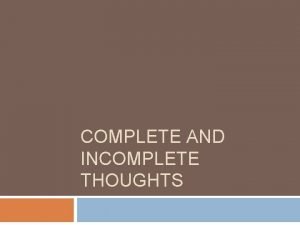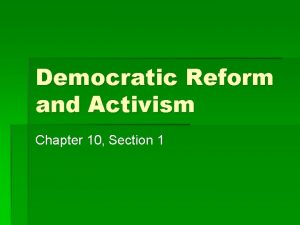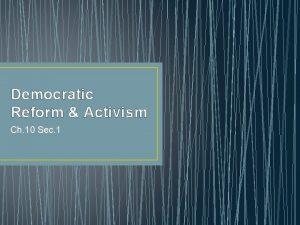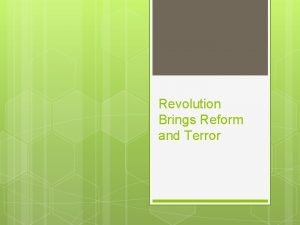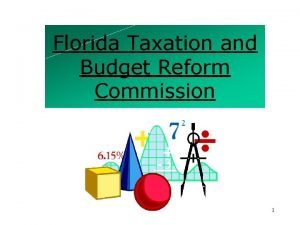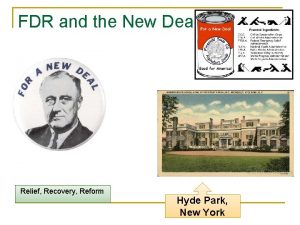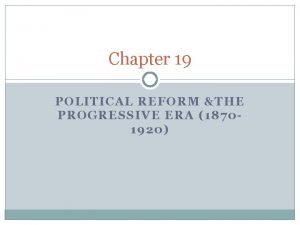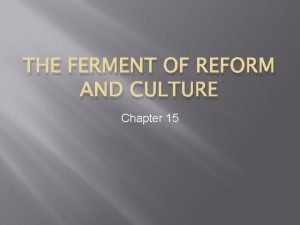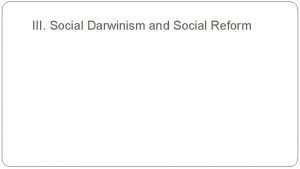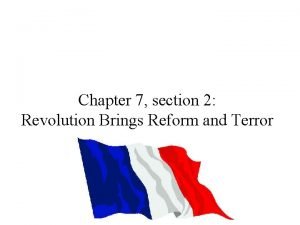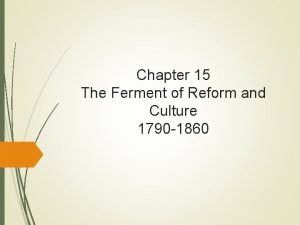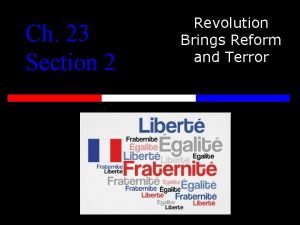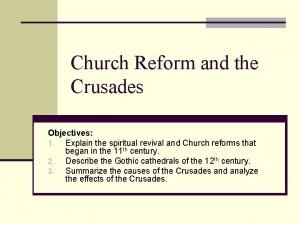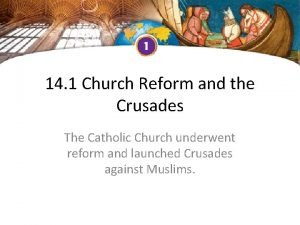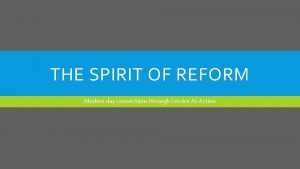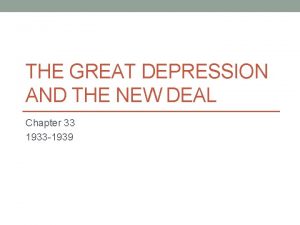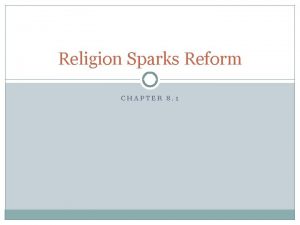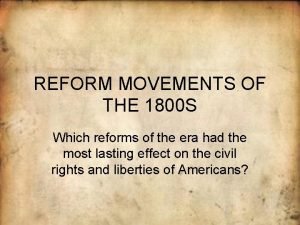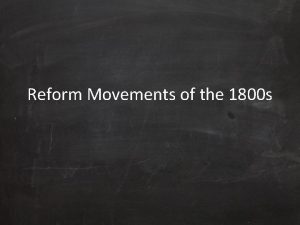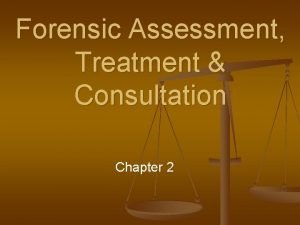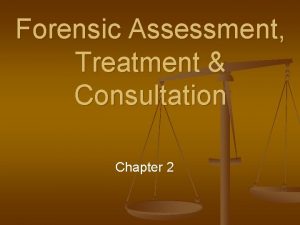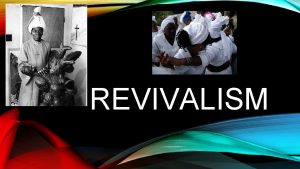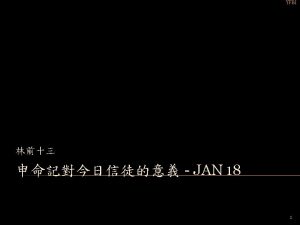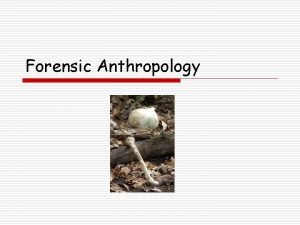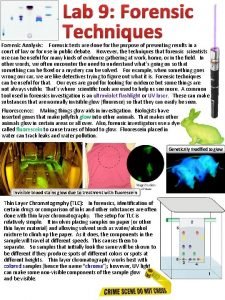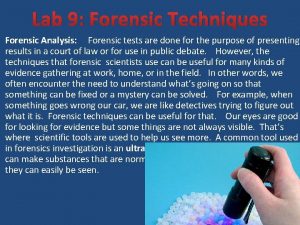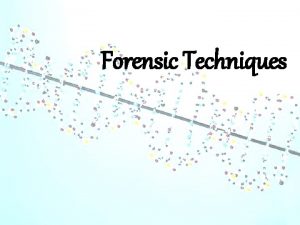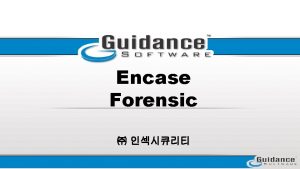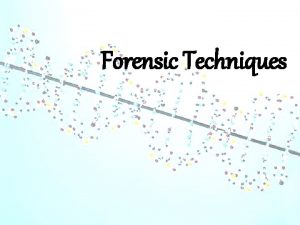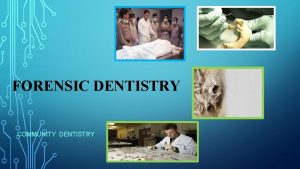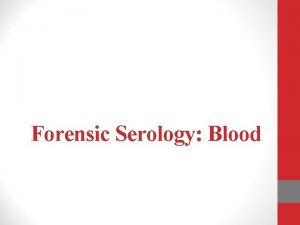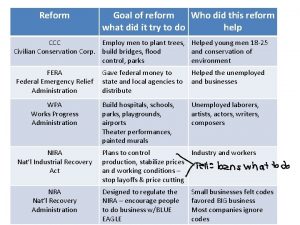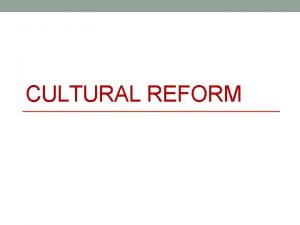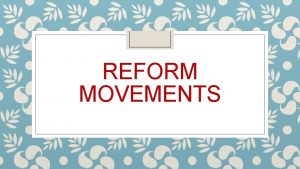The Forensic Assessment of Thought Reform and Cultic



































































- Slides: 67

The Forensic Assessment of Thought Reform and Cultic Processes Steve K. D. Eichel, Ph. D. , ABPP, CST, CCFC

The Forensic Assessment of Thought Reform and Cultic Processes Who is this program intended for? • • Mental health professionals engaged in forensic evaluations, both criminal & civil. Officers of the Court (attorneys, masters, judges). Law Enforcement specialists (e. g. , IPV, fraud, racketeering, human trafficking, hostages, counter-terrorism). Custody evaluators.

What is a Cult? Because the term “cult” has different meanings (e. g. , the Elvis cult, the cult of personality) and has often been misused, associations like ICSA recommend the use of more accurate terminology, such as “coercive group” or “destructive cult. ” My personal favorite is “High Demand Group” (HDG).

What is a Cult/HDG? An ideological organization held together by charismatic relationships and demanding high levels of commitment.

Peoples Temple November 18, 1978 Jonestown, Guyana Leader: Jim Jones Deaths: 917 278 Children under age of 10 US Congressman Leo J. Ryan

Order of Solar Temple Oct. 1994; Dec. 1995; Mar. 1996 Switzerland, France, Quebec Leaders: Luc Jouret & Joseph di Mambro Deaths: 74 Total 53 in ‘ 94 16 in ‘ 95 5 in ‘ 96

Question… There have been two bioterror attacks in the U. S. One involved the infamous “anthrax letters” sent in 2001 that resulted in 5 deaths. What was the other (larger) attack?

Answer… The 1984 Rajneeshee bioterror attack was the food poisoning of 751 individuals in The Dalles, Oregon, through the deliberate contamination of salad bars at ten local restaurants with salmonella. A leading group of followers of Bhagwan Shree Rajneesh (later known as Osho) had hoped to incapacitate the voting population of the city so that their own candidates would win the 1984 Wasco County elections. The incident was the first and single largest bioterrorist attack in United States history. The attack is one of only two confirmed terrorist uses of biological weapons to harm U. S. citizens.

Aum Shinrikyo March 20, 1995 Tokyo, Japan Leader: Shoko Asahara - Convicted; sentenced to be executed (not carried out as of 7/27/15). Sarin gas released in subway Deaths: 12 Injured: 5, 500

What is a Cult/HDG? • • Rigid hierarchies - Flawless/divine leader - Inner circle (second tier) that typically hides information from “general” membership (third tier) Downward flow of information and power - Criticism and dissent are ignored (best case) or punished (worst case) - Lack of accountability - Decision-making is consolidated at the top Rigid boundaries; “outside” is demonized Use of thought-control themes and processes (to be delineated)

Most HDGs fall into one of these categories: • • • Religious - Bible-based - Fundamentalist (Christian, Jewish, Islamic, etc. ) Political - Revolutionary (Left, Right, Anarchist/Libertarian) - Christian Identity movement (often hybrid) - “Freemen” (anarcho/anti-government Marketing (e. g. , multilevel marketing, often incorporates religious or “New Age” beliefs and practices)

Most HDGs fall into one of these categories: Therapy/Pseudo-therapy - Bible-based - Fundamentalist (Christian, Jewish, Islamic, etc. ) • “New Age” • Hybrid - Self-help/religious - Political/therapeutic - Religious/political Most common: fundamentalist Christian and/or Bible-based HDGs.

What is a Cult/HDG? – Charisma and High Demands Charisma refers to a spiritual power or personal quality that gives an individual influence or authority over large numbers of people. Hence, a cult is characterized by an ideology, strong demands issuing from that ideology, and powerful processes of socialpsychological influence to induce group members to meet those demands.

Cultic Processes Presence of Themes/Processes in HDGs (from Robert Jay Lifton) 1. Milieu control. 2. Loading the language. 3. Demand for purity. 4. Confession. 5. Mystical manipulation. 6. Doctrine over person. 7. Sacred science. 8. Dispensing of existence.

Dr. Robert J. Lifton's Eight Criteria for Thought Reform 1. Milieu Control This involves the control of information and communication both within the environment and, ultimately, within the individual, resulting in a significant degree of isolation from society at large. 2. Mystical Manipulation. There is manipulation of experiences that appear spontaneous but in fact were planned and orchestrated by the group or its leaders in order to demonstrate divine authority or spiritual advancement or some special gift or talent that will then allow the leader to reinterpret events, scripture, and experiences as he or she wishes. 3. Demand for Purity. The world is viewed as black and white and the members are constantly exhorted to conform to the ideology of the group and strive for perfection. The induction of guilt and/or shame is a powerful control device used here.

Dr. Robert J. Lifton's Eight Criteria for Thought Reform 4. Confession. Sins, as defined by the group, are to be confessed either to a personal monitor or publicly to the group. There is no confidentiality; members' "sins, " "attitudes, " and "faults" are discussed and exploited by the leaders. 5. Sacred Science. The group's doctrine or ideology is considered to be the ultimate Truth, beyond all questioning or dispute. Truth is not to be found outside the group. The leader, as the spokesperson for God or for all humanity, is likewise above criticism. 6. Loading the Language. The group interprets or uses words and phrases in new ways so that often the outside world does not understand. This jargon consists of thought-terminating cliché, which serve to alter members' thought processes to conform to the group's way of thinking.

Dr. Robert J. Lifton's Eight Criteria for Thought Reform 7. Doctrine over person. Member's personal experiences are subordinated to the sacred science and any contrary experiences must be denied or reinterpreted to fit the ideology of the group. 8. Dispensing of existence. The group has the prerogative to decide who has the right to exist and who does not. This is usually not literal but means that those in the outside world are not saved, unenlightened, unconscious and they must be converted to the group's ideology. If they do not join the group or are critical of the group, then they must be rejected by the members. Thus, the outside world loses all credibility. In conjunction, should any member leave the group, he or she must be rejected also.

From Captive Hearts, Captive Minds: Freedom and Recovery from Cults and Abusive Relationships Madeleine L. Tobias and Janja Lalich The similarities between cultic devotion and the traumatic bonding that occurs between battered individuals and their abusers (e. g. , IPV, pimp-prostitute relationships) are striking. An abused partner is generally made to submit to the following types of behaviors: * early verbal and/or physical dominance, * isolation/imprisonment * fear arousal and maintenance * guilt induction * contingent expressions of "love" * enforced loyalty to the aggressor and self-denunciation * promotion of powerlessness and helplessness * pathological expressions of jealousy * hope-instilling behaviors * required secrecy

Themes/Processes in cults (from Margaret Singer) • • • Keep the person unaware of what is going on and the changes taking place. Control the person's time and, if possible, physical environment. Create a sense of powerlessness, covert fear, and dependency. Suppress much of the person's old behavior and attitudes. Instill new behavior and attitudes.

Themes/Processes in cults (from Michael Langone) 1. Dependency (on the group, on the leader). 2. Debilitation (of physical, emotional, intellectual functioning). 3. Dread (of the “outside” world, of consequences of leaving the group (“exit costs” and induction of phobias). These processes occur in cults and in other cultic relationships, such as abusive marriages (couples), in trafficking, in gaslighting, etc.

Underlying Assumption (i. e. , sorry, but it’s not black & white) "Some groups may harm some people sometimes, and some groups may be more likely to harm people than other groups" (Langone, 2001, p. 3).

How Many People in Cults/HDGs? Research suggests that one percent of the U. S. population (about three million persons) have been involved in cultic groups and perhaps as many as one-hundred-thousand people enter and leave cultic groups each year (Langone; Rosedale & Langone). Similar percentages have been found in a study in Spain (A. I. S. , 2005).

How Many Cults/HDGs? ICSA has information in its files on or has been contacted about over 4000 groups, many of which have been the object of critical news reports. However, the percentage of these groups that could be categorized as "cults" is unknown.

How are People Harmed? ICSA's research indicates that cultic and other high control groups vary enormously in their potential for harm. Pat & Joe

Harm may be physical, psychological, economic, social, and/or spiritual. Pat & Joe

Kinds of Harm Observed Destruction of family relationships Odd beliefs resistant to discussion Engages in anti-social behavior that is out of character Reckless, self-destructive behavior Exhaustion Dropping out of college Diminished capacity to think critically Pat & Joe

What Can Elicit an Alarm? Out-of-character behavioral changes Black and white thinking Secrecy Lack of contact Symbols Major change of goals Pat & Joe

Cultic processes In evaluating cultic groups and cultic relationships (e. g. , “ 1 -on-1” abusive relationships, such as those often found in IPV, or “small” groups such as those found in some forms of trafficking) it is helpful to analyze the extent to which the group or individual utilizes cultic processes.

The Forensic Assessment of Thought Reform and Cultic Processes Why is this workshop relevant? Without specific tools for assessing an HDG situation, it is easy for the evaluator to be misled or fooled.

The Forensic Assessment of Thought Reform and Cultic Processes Why is this workshop relevant? Bringing up “cults” in forensic evaluations without a clear strategy can result in unintentional intrusions into First Amendment rights.

The Forensic Assessment of Thought Reform and Cultic Processes In some cases, HDGs or their allies will threaten and/or file suits against evaluators who are critical of them.

Continuum of Influence & Persuasion Education Advertising Propaganda Indoctrination Thought Reform Focus of body of knowledge Many bodies of knowledge, based on scientific findings in various fields. Body of knowledge concerns product, competitors; how to sell and influence via legal persuasion. Body of knowledge is explicitly designed to inculcate organizational values. Body of knowledge centers on political persuasion of masses of people. Body of knowledge centers on changing people without their knowledge. Direction & degree of exchange Two way pupil-teacher exchange encouraged. Exchange can occur but communication generally one-sided. Some exchange occurs but communication generally one-sided. Limited exchange occurs, communication is one-sided. No exchange occurs, communication is onesided. Ability to change Change occurs as science advances; as students and other scholars offer criticisms; as students & citizens evaluate programs. Change made by those who pay for it, based upon the success of ad programs by consumers law, & in response to consumer complaints. Change based on changing tides in world politics and on political need to promote the group, nation, or international organization. Change made through formal channels, via written suggestions to higher-ups. Change occurs rarely; organization remains fairly rigid; change occurs primarily to improve thought-reform effectiveness. Structure of persuasion Uses teacher-pupil structure; logical thinking encouraged. Uses an instructional mode to persuade consumer/buyer. Takes authoritarian stance to persuade masses. Takes authoritarian & hierarchical stance; No full awareness on part of learner. Type of relationship Instruction is timelimited: consensual. Consumer/buyer can accept or ignore communication. Learner support & engrossment expected. Instruction is contractual: consensual Group attempts to retain people forever. Deceptiveness Is not deceptive. Can be deceptive, selecting only positive views. Can be deceptive, often exaggerated. Is not deceptive. Is deceptive. Breadth of learning Focuses on learning to learn & learning about reality; broad goal is rounded knowledge for development of the individual. Has a narrow goal of swaying opinion to promote and sell an idea, object, or program; another goal is to enhance seller & possibly buyer. Targets large political masses to make them believe a specific view or circumstance is good. Stresses narrow learning for a specific goal; to become something or to train for performance of duties. Individualized target; hidden agenda (you will be changed one step at a time to become deployable to serve leaders). Tolerance Respects differences. Puts down competition. Wants to lessen opposition. Aware of differences. No respect for differences. Methods Instructional techniques. Mild to heavy persuasion. Overt persuasion sometimes unethical. Disciplinary techniques. Improper and unethical techniques.

Criteria for Thought Reform Conditions Themes Stages (Singer) (Lifton) (Schein) 1. Keep the person unaware of what is going on and the changes taking place. 2. Control the person's time and, if possible, physical environment. 3. Create a sense of powerlessness, covert fear, and dependency. 1. Unfreezing. 1. Milieu control. 2. Loading the language. 3. Demand for purity. 4. Suppress much of the person's old behavior and attitudes. 4. Confession. 5. Instill new behavior and attitudes. 5. Mystical manipulation. 2. Changing. 6. Doctrine over person. 6. Put forth a closed system of logic; allow no real input or criticism. 7. Sacred science. 8. Dispensing of existence. 3. Refreezing.

Cultic Relationship

Indoctrination & Extreme Indoctrination (Mind Control or “Brainwashing”)

Points to consider during evaluation. The evaluator needs to be versed in social and group psychology as well as family and individual psychology. Sources of information: family, collateral witnesses, internet, current and former members, HDG experts, public and private investigations.

Points to consider during evaluation. Group structure: Group boundaries Group hierarchy Method(s) for inducing changes in: Beliefs Emotions Behaviors Personality (presence of “doubling”) Prior to HDG (“pre-cult”) exposure: Beliefs Behaviors Personality

Points to consider during evaluation. Themes (Lifton) 1. Milieu control. 2. Loading the language. 3. Demand for purity. 4. Confession. Themes (Lifton) 5. Mystical manipulation. 6. Doctrine over person. 7. Sacred science. 8. Dispensing of existence.

Points to consider during evaluation. Conditions (Singer) 1. Keep the person unaware of what is going on and the changes taking place. 2. Control the person's time and, if possible, physical environment. 3. Create a sense of powerlessness, covert fear, and dependency. 4. Suppress much of the person's old behavior and attitudes. 5. Instill new behavior and attitudes. 6. Put forth a closed system of logic; allow no real input or criticism.

Issues for the Evaluator How do differences in evidentiary standards between criminal and civil (including domestic and custody) cases affect the expert’s handling of the cult issue? • When should the expert utilize terms like “cult” or “thought reform? ” (Hint: Juries, yes; Judges, no. ) • When is it best to limit discussion to less controversial and better understood social psychological processes? (Hint: Judges, yes; Juries, maybe. )

Issues for the Evaluator A major challenge: How do we present cultic indoctrination as (1) normal enough that anyone can potentially be “brainwashed”, yet (2) powerful enough to induce highly abnormal, even harmful behavior? The simpler the story, the better. Using “con artist” examples are often a good approach, since many people can relate to being conned (they or someone close to them may have experienced it).

Issues for the Evaluator Maintaining objectivity in emotionally charged situations. • It is important to educate attorneys and clients about your role. • It may be important to explore the “benefit” derived by being in an HDG. • In testifying, it is a challenge to avoid using absolutist, black vs. white language yet convey to a judge and/or jury that cultic behavior and actions can ultimately be amoral.

Issues for the Evaluator Choosing tests and evaluation methods: • Stay within the limits of your expertise. • Juries often do not find tests especially persuasive. • While it can be valuable and important to be able to refer to tests as one of the bases forming an opinion, the tests themselves are often puzzling and even meaningless to judges and juries. • When using tests, always include one of the two most widely-used personality tests, the MMPI and the MCMI. They both meet Daubert standards. Only refer to individualized intelligence or achievement tests (Wechsler, Wide-Range). Projectives are useful only as ancillary or supplementary tests. • Juries find persuasive experts persuasive.

Issues for the Evaluator Countering the “brainwashing doesn’t exist” argument. • Know the APA resolution (it does not say “brainwashing” does not exist; it says the jury is out). Know Phil Zimbardo’s (recent past-President of APA) research and views. • It is often best to stick with proven legal constructs like undue influence, irresistible impulse, and confidence games (deception and fraud).

MMPI Minnesota Multiphasic Personality Inventory MMPI-2 – – 567 items 370 items short form MMPI-2 RC – Restructured Clinical scales MMPI-2 -RF – Restructured Form MMPI-A – Adolescent – 478 items – 350 items short form

MMPI-2 Validity Scales Look for peaks at L.

MMPI-2 Basic Clinical Scales

Other MMPI-2 Scales MMPI-2 PSY-5 Scales 1. Negative Emotionality (NEGE) 2. Psychoticism (PSYC) 3. Introversion (INTR) 4. Disconstraint (DISC) 5. Aggressiveness (AGGR) Look for significant deviations from collateral reports of “pre. HDG” personality.

Other MMPI-2 Scales MMPI-2 RC (Reconstructed Clinical) Scales Look closely at RC 4, RC 6 and RC 8.

MMPI-2 Hints • • Look for indicators of self-righteousness, rigidity, denial and poor insight. These are more often found in the validity scales (e. g. , elevated L) than in the clinical scales. ?

MMPI-2 Content Scales Look for peaks at OH, R and MDS.

MMPI-2 -RF Validity Indices ? Cannot Say (raw score only) VRIN-r Variable Response Inconsistency TRIN-r True Response Inconsistency F-r Infrequent Responses Fp-r Infrequent Psychopathology Responses Fs Infrequent Somatic Responses FBS-r Symptom Validity (“Fake Bad” Scale) L-r Uncommon Virtues K-r Adjustment Validity

MMPI-2 -RF Higher-Order (H-O) EID Emotional/Internalizing Dysfunction THD Thought Dysfunction BXD Behavioral/Externalizing Dysfunction

MMPI-2 -RF RC (Restructured Clinical) RCd RC 1 RC 2 RC 3 RC 4 RC 6 RC 7 RC 8 RC 9 Demoralization Somatic Complaints Low Positive Emotions Cynicism Antisocial Behavior Ideas of Persecution Dysfunctional Negative Emotions Aberrant Experiences Hypomanic Activation

MMPI-2 -RF Somatic/Cognitive and Internalizing Somatic/Cognitive MLS Malaise GICGastrointestinal Complaints HPC Head Pain Complaints NUC Neurological Complaints COG Cognitive Complaints

MMPI-2 -RF Somatic/Cognitive and Internalizing Scales SUI Suicidal/Death Ideation HLP Helplessness/Hopelessness SFD Self-Doubt NFC Inefficacy STW Stress/Worry AXY Anxiety ANP Anger Proneness BRF Behavior-Restricting Fears MSF Multiple Specific Fears

MMPI-2 -RF Externalizing, Interpersonal, and Interest Externalizing JCP SUB AGG ACT Juvenile Conduct Problems Substance Abuse Aggression Activation Interpersonal Scales FML Family Problems IPP Interpersonal Passivity SAV Social Avoidance SHY Shyness DSF Disaffiliativeness

MMPI-2 -RF Externalizing, Interpersonal, and Interest Scales AES MEC Aesthetic-Literary Interests Mechanical-Physical Interests

MMPI-2 -RF Personality Psychopathology Five (PSY-5) Scales (r=Revised) AGGR-r PSYC-r DISC-r NEGE-r INTR-r Aggressiveness Psychoticism Disconstraint-Revised Negative Emotionality/Neuroticism Introversion/Low Positive Emotionality

The Forensic Assessment of Thought Reform and Cultic Processes Children

The Forensic Assessment of Thought Reform and Cultic Processes Children in the custody of HDGinvolved parents have a higher incidence of neglect, physical/sexual abuse, and disturbed or disrupted development.

Cultic and related authoritarian groups threaten children because they: 1. 2. Cults live by an absolutist ideology that dictates harsh physical discipline and/or the rejection of medical intervention. Cults function as closed, often physically isolated, societies which resist any investigation of possible child abuse.

Cultic and related authoritarian groups threaten children because they: 3. Cults use religious/political/psychological beliefs to justify their ideology and reclusive nature. Their absolutist ideology provides a rationalization for child abuse. Their limited interaction with members of mainstream society (e. g. , members don't visit doctors; children attend group-run schools) tends to close off the normal means by which authorities learn about child abuse and neglect.

Assessing children • • • If possible, meet with the children in a variety of locations: – Each parents’ home (if divorced). – School. – The HDG (in the presence of leader? ). Be prepared to be “preached at” With older children, there may have to be some self-disclosure.

Assessing children • • • With older children, there may have to be some self-disclosure. Alienation is very common and needs to be carefully assessed in the context of the HDG, its leader(s) and its belief system. If possible, talk with former members who also had children in the group. If possible, explore how former members are viewed/treated by the HDG, the parents and the children.

Assessing children • • I believe it is almost always necessary to understand thoroughly explore the HDG’s belief system. I typically include this as an Appendix to my report rather than within the body; I am trying to avoid a First Amendment challenge. In my experience, most courts will allow testimony about beliefs but only in so far as they are relevant to parental and/or child behavior. In court, I usually wait to be asked about beliefs rather than introduce them myself (e. g. , wait for an attorney or judge to ask, “What are the reasons that the child refusing to talk with mom/dad? ”).

Assessing children • Evaluate the impact of the HDG on child development (the good as well as the bad). Areas to consider: – Education – Medical care – Socialization – Guilt/shame – Sexuality and/or sexual development – Appreciation of unique skills or talents (e. g. , art, music, science)
 Forensic anthropologist vs forensic pathologist
Forensic anthropologist vs forensic pathologist Who is this
Who is this Complete and incomplete thought
Complete and incomplete thought Democratic reform and activism
Democratic reform and activism Chapter 10 section 1 democratic reform and activism
Chapter 10 section 1 democratic reform and activism Chapter 23 lesson 3 nationalism unification and reform
Chapter 23 lesson 3 nationalism unification and reform The ferment of reform and culture
The ferment of reform and culture Revolution brings reform and terror
Revolution brings reform and terror Taxation and budget reform commission
Taxation and budget reform commission Examples of relief recovery and reform
Examples of relief recovery and reform Chapter 19 political reform and the progressive era
Chapter 19 political reform and the progressive era The ferment of reform and culture
The ferment of reform and culture What was reform darwinism?
What was reform darwinism? Chapter 7 section 2 revolution brings reform and terror
Chapter 7 section 2 revolution brings reform and terror Chapter 15 the ferment of reform and culture
Chapter 15 the ferment of reform and culture Chapter 12 religion romanticism and reform
Chapter 12 religion romanticism and reform Chapter 23 section 2 revolution brings reform and terror
Chapter 23 section 2 revolution brings reform and terror The ferment of reform and culture
The ferment of reform and culture Second great awakening
Second great awakening Church reform and the crusades
Church reform and the crusades Chapter 14 section 1 church reform and the crusades
Chapter 14 section 1 church reform and the crusades Hình ảnh bộ gõ cơ thể búng tay
Hình ảnh bộ gõ cơ thể búng tay Ng-html
Ng-html Bổ thể
Bổ thể Tỉ lệ cơ thể trẻ em
Tỉ lệ cơ thể trẻ em Chó sói
Chó sói Tư thế worm breton là gì
Tư thế worm breton là gì Chúa yêu trần thế
Chúa yêu trần thế Các môn thể thao bắt đầu bằng tiếng bóng
Các môn thể thao bắt đầu bằng tiếng bóng Thế nào là hệ số cao nhất
Thế nào là hệ số cao nhất Các châu lục và đại dương trên thế giới
Các châu lục và đại dương trên thế giới Công thức tính độ biến thiên đông lượng
Công thức tính độ biến thiên đông lượng Trời xanh đây là của chúng ta thể thơ
Trời xanh đây là của chúng ta thể thơ Mật thư anh em như thể tay chân
Mật thư anh em như thể tay chân Làm thế nào để 102-1=99
Làm thế nào để 102-1=99 độ dài liên kết
độ dài liên kết Các châu lục và đại dương trên thế giới
Các châu lục và đại dương trên thế giới Thể thơ truyền thống
Thể thơ truyền thống Quá trình desamine hóa có thể tạo ra
Quá trình desamine hóa có thể tạo ra Một số thể thơ truyền thống
Một số thể thơ truyền thống Cái miệng nó xinh thế chỉ nói điều hay thôi
Cái miệng nó xinh thế chỉ nói điều hay thôi Vẽ hình chiếu vuông góc của vật thể sau
Vẽ hình chiếu vuông góc của vật thể sau Biện pháp chống mỏi cơ
Biện pháp chống mỏi cơ đặc điểm cơ thể của người tối cổ
đặc điểm cơ thể của người tối cổ V cc cc
V cc cc Vẽ hình chiếu đứng bằng cạnh của vật thể
Vẽ hình chiếu đứng bằng cạnh của vật thể Vẽ hình chiếu vuông góc của vật thể sau
Vẽ hình chiếu vuông góc của vật thể sau Thẻ vin
Thẻ vin đại từ thay thế
đại từ thay thế điện thế nghỉ
điện thế nghỉ Tư thế ngồi viết
Tư thế ngồi viết Diễn thế sinh thái là
Diễn thế sinh thái là Các loại đột biến cấu trúc nhiễm sắc thể
Các loại đột biến cấu trúc nhiễm sắc thể Thế nào là số nguyên tố
Thế nào là số nguyên tố Tư thế ngồi viết
Tư thế ngồi viết Lời thề hippocrates
Lời thề hippocrates Thiếu nhi thế giới liên hoan
Thiếu nhi thế giới liên hoan ưu thế lai là gì
ưu thế lai là gì Hổ sinh sản vào mùa nào
Hổ sinh sản vào mùa nào Khi nào hổ mẹ dạy hổ con săn mồi
Khi nào hổ mẹ dạy hổ con săn mồi Sơ đồ cơ thể người
Sơ đồ cơ thể người Từ ngữ thể hiện lòng nhân hậu
Từ ngữ thể hiện lòng nhân hậu Thế nào là mạng điện lắp đặt kiểu nổi
Thế nào là mạng điện lắp đặt kiểu nổi The spirit of reform lesson 1
The spirit of reform lesson 1 Was the tva a relief recovery reform
Was the tva a relief recovery reform Religion sparks reform chapter 8
Religion sparks reform chapter 8 When was the education reform movement
When was the education reform movement Reform movements 1800s
Reform movements 1800s


